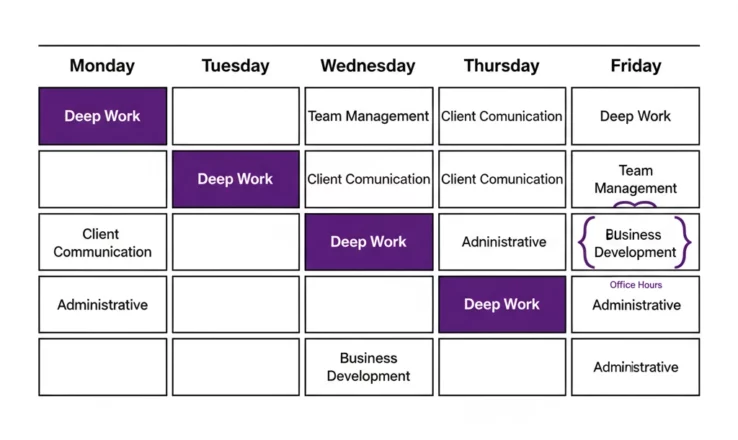
Your calendar isn't just a scheduling tool, it's a weapon. And if you're not wielding it strategically, you're bleeding time and profits every single day.
Here's the brutal truth: Most agency owners treat their calendars like suggestion boxes. Client calls get squeezed in whenever. Internal work happens "when there's time." Strategic planning gets pushed to "next week." Sound familiar?
This reactive approach is killing your agency's growth potential. But there's a fix, and it starts with embracing one simple mantra: "If it's not in my calendar, it doesn't exist."
Let me show you how to transform your calendar from a passive scheduling tool into an active profit-protection system that drives agency growth.
Why Most Agencies Fail at Time Management (And What It's Costing You)
Before we dive into the solution, you need to understand the magnitude of this problem. When you don't control your calendar, three critical things happen:
First, you lose your highest-value work. Strategic planning, business development, and team coaching, the activities that actually scale your agency, get pushed aside for "urgent" client requests and reactive tasks.
Second, your time tracking becomes worthless. Without disciplined calendar blocking, your team can't accurately track time, which means your resource management is based on guesswork. You can't optimize utilization rates if you don't know where time is actually going.
Third, your profit margins erode. Poor time tracking leads to underestimating project scope, overservicing clients, and missing opportunities to optimize your team's billable capacity.
This isn't just about productivity, it's about your agency's financial health.
The Calendar-First Methodology: Your New Operating System
Time blocking transforms your calendar from a reactive scheduling nightmare into a proactive business management tool. Here's how it works:
Step 1: Audit Your Current Time Reality
Before you can fix your calendar, you need to see the damage. For the next three days, track every single thing you do in 15-minute increments. Yes, it's tedious. Do it anyway.
You'll discover that "quick client calls" actually take 45 minutes when you factor in prep and follow-up. That "five-minute Slack check" turns into 30 minutes of context switching. This audit reveals where your time actually goes versus where you think it goes.
Step 2: Identify Your High-Impact Time Blocks
Now categorize your work into these buckets:
- Deep Work: Strategy, planning, complex problem-solving
- Client Communication: Calls, emails, project reviews
- Team Management: One-on-ones, feedback, coaching
- Business Development: Sales calls, proposal writing, networking
- Administrative: Time tracking, invoicing, internal processes
Each category gets dedicated calendar blocks. No exceptions.

Step 3: Implement the "If It's Not Scheduled, It Doesn't Exist" Rule
This is where most agencies fail. They create beautiful time blocks, then immediately start making exceptions. Client emergency? Squeeze it in between blocks. Team member needs "just five minutes"? Sure, we'll find time.
Stop. Every request: internal or external: must be evaluated against your protected time blocks. If it's truly urgent, something else gets moved. If it's not, it waits for the appropriate scheduled time.
Connecting Time Blocking to Agency Profitability
Here's where time blocking becomes a growth engine for your agency, not just a personal productivity hack.
Accurate Time Tracking = Better Resource Management
When every team member adopts calendar-first scheduling, your time tracking accuracy skyrockets. Instead of trying to remember what they worked on last Tuesday, team members simply reference their calendars.
This accuracy feeds directly into three profit-critical areas:
- Project Scoping: Historical time data helps you price new projects based on reality, not optimistic estimates
- Resource Allocation: You can see exactly where your team's capacity is being used and identify optimization opportunities
- Utilization Forecasting: Predictable scheduling allows you to forecast billable hours and identify when to hire or reassign resources
Capacity Visualization for Strategic Growth
Time blocking makes your agency's capacity visual and measurable. When a potential client wants to start next month, you can look at your team's calendars and give accurate timelines based on actual availability, not gut feelings.
This visibility enables better growth decisions. Should you hire another strategist or project manager? Your blocked calendars show exactly where the bottlenecks are.
Implementation Framework: Building Your Calendar Culture
Phase 1: Leadership Modeling (Week 1-2)
You go first. Block your entire calendar for the next two weeks using the methodology above. Share your blocked calendar with your team and explain what you're doing and why.
Show them how client requests now get evaluated against your protected time blocks. Demonstrate how this improves your response quality and reduces stress.
Phase 2: Team Rollout (Week 3-4)
Now bring your team into the process. Have each team member create their own time blocking system using these guidelines:
- Morning Deep Work Block: 2-3 hours of focused project work
- Communication Windows: Designated times for emails, Slack, and client calls
- Buffer Blocks: 30-minute buffers between meetings for notes and transition
- Weekly Planning Block: 1 hour every Friday to plan next week's blocks
Make calendar blocking a requirement, not a suggestion. This becomes part of your agency's operating procedures.

Phase 3: Integration with Time Tracking (Week 5-6)
Connect your calendar blocks directly to your time tracking system. Most agencies use tools like Harvest, Toggl, or built-in tracking in project management platforms.
Train your team to start timers based on calendar blocks, not when they remember to hit the button. This creates seamless, accurate time capture that feeds your resource management and profitability analysis.
Advanced Calendar Strategies for Agency Growth
Client Communication Boundaries
Implement "office hours" for client communication. Instead of being available whenever clients call, establish specific windows for client calls and communication. For example:
- Monday/Wednesday/Friday: 2-5 PM for client calls
- Tuesday/Thursday: Internal work and strategy days
- Email responses within 24 hours, not immediately
This approach actually improves client relationships because your responses are more thoughtful and strategic.
Meeting Audit and Optimization
Review every recurring meeting in your agency. Ask:
- What's the specific outcome this meeting achieves?
- Could this be handled asynchronously?
- Who actually needs to be here?
Ruthlessly cut meetings that don't directly contribute to project delivery or team development. Your calendar is too valuable for status updates that could be Slack messages.
The Weekly Planning Ritual
Every Friday at 4 PM, spend 30 minutes planning next week's calendar blocks. Review:
- Project deadlines and deliverables
- Team capacity and availability
- Client communication requirements
- Internal priorities and strategy work
This weekly planning session is non-negotiable. It's the foundation that makes everything else work.
Measuring Success: Metrics That Matter
Track these key indicators to measure how calendar-first operations impact your agency:
Time Tracking Accuracy: Compare logged hours to scheduled blocks. You should see 85%+ accuracy within 30 days.
Utilization Rates: With accurate time tracking, you can calculate true utilization rates and identify optimization opportunities.
Project Delivery: On-time project delivery should improve as team members have protected time for deep work.
Revenue Per Employee: Better resource management typically increases revenue per team member by 15-25% within six months.
Don't just track these metrics: use them to continuously optimize your calendar strategy and resource allocation.
Making It Stick: Building Long-Term Calendar Discipline
The biggest challenge isn't learning time blocking: it's maintaining the discipline when things get busy. Here's how to build lasting change:
Weekly Team Check-ins: During team meetings, have each person share one success and one challenge from their time blocking practice. This creates accountability and shared learning.
Calendar Transparency: Make team calendars visible to each other. This reduces interruptions and helps everyone respect blocked time.
Regular System Updates: Monthly, review what's working and what isn't. Adjust block durations, meeting windows, and communication protocols based on real experience.
Remember: Your calendar is your agency's growth engine. Every hour you protect through disciplined time blocking is an hour that can be optimized for profit, strategic work, and sustainable growth.
The agencies that master calendar-first operations don't just survive: they thrive while their competitors burn out trying to do everything for everyone all the time.
Start tomorrow. Block your calendar for the next two weeks. Make it non-negotiable.
Your future self (and your profit margins) will thank you.
